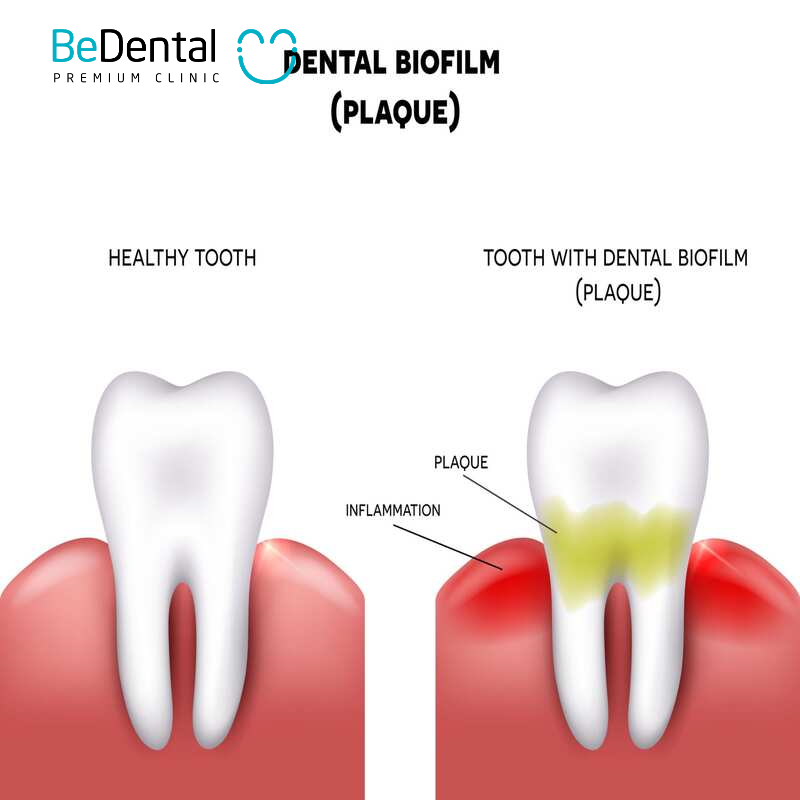Understanding the difference between plaque and tartar is key to maintaining good oral health. While plaque is easy to control and remove with daily care, tartar is a more serious issue that requires professional dental treatment. Ignoring plaque can lead to the formation of hard tartar, which negatively impacts oral health. Recognizing this distinction helps you maintain a healthy smile and prevent potential dental problems.
Distinguishing The Difference Between Plaque and Tartar
Distinguishing The Difference Between Plaque and Tartar Both plaque and tartar are common oral health concerns, resulting from the accumulation of bacteria and food debris on the teeth. While they share the same origin, their impact on oral health varies. Both can lead to cavities, gum inflammation, and more serious conditions if not addressed. However, there are clear differences in their characteristics and treatment approaches.
- Plaque: Plaque is a soft, colorless film that forms on the surface of teeth and gums after eating. It consists of bacteria, food particles, and proteins from saliva. Plaque can be easily removed through regular brushing and flossing. If left untreated, plaque contributes to tooth decay and gum disease.
- Tartar: Tartar is hardened plaque that has calcified and adhered firmly to the teeth. It typically appears yellow or brown and cannot be removed through regular brushing or flossing. Tartar forms when plaque is not cleared in time, requiring dental procedures like scaling to remove. It is a leading cause of gum disease and other periodontal issues.

The main Difference Between Plaque and Tartar (What’s the difference between Plaque and tartar?) lies in the nature and treatment of these conditions. Plaque is a soft, colorless film that can be easily cleaned away with daily oral hygiene. In contrast, tartar is hardened, calcified plaque that sticks to the teeth and requires professional intervention to remove. Plaque is the precursor to tartar, and if neglected, it will eventually turn into tartar over time.
In summary, plaque is the initial stage that can be managed with proper oral care, while tartar is the result of untreated plaque that must be addressed by a dentist.
Differences Between Plaque and Tartar
The distinction between plaque and tartar can be broken down into three key aspects: differences in nature, formation time, and treatment methods.
Nature Plaque and tartar differ significantly in their physical characteristics.
Plaque is a soft, nearly invisible layer that can be easily removed by brushing. Tartar, on the other hand, is the result of long-standing plaque that has calcified, becoming hard and firmly attached to the teeth. This makes tartar more difficult to detect in its early stages and much harder to remove without professional care. Essentially, plaque is mild and manageable, while tartar is a more severe issue requiring specialized treatment.
- Plaque: A soft, colorless film that can be easily removed through daily oral hygiene.
- Tartar: A hard, calcified buildup that adheres to the teeth and requires professional cleaning. Tartar typically appears yellow or brown.
Difference in Causes and Time of Formation
Formation Time Plaque forms quickly, building up on teeth every day after eating when food and bacteria accumulate on the tooth surfaces. Plaques can appear within a few hours if oral hygiene is neglected. However, tartar takes longer to form, developing from untreated plaque over several days or weeks. If plaque isn’t removed promptly, it hardens into tartar, highlighting the importance of daily dental care.
- Plaque: Forms daily, especially after meals, if oral hygiene is neglected.
- Tartar: Forms over time when plaque is not removed and calcifies.

Difference in Removal Methods
Treatment Methods The treatment for plaque and tartar varies greatly. Plaque can be easily eliminated with proper brushing and flossing, which means individuals can manage it at home. Tartar, on the other hand, cannot be removed by brushing or flossing once it has hardened. Removing tartar requires professional dental treatment, such as scaling, to break it away from the teeth. This highlights the difference in severity and treatment between the two conditions.
- Plaque: Easily removed with regular brushing and flossing.
- Tartar: Requires professional intervention, typically through scaling or ultrasonic cleaning.
Important Tips for Preventing Plaque and Tartar
Plaque can be removed at home, tartar cannot: Tips for Preventing Plaque and Tartar Plaque is easy to remove with daily care, but tartar is not. Since plaque is a soft film, regular brushing and flossing are essential to prevent its buildup. If neglected, plaque will harden into tartar, which adheres firmly to the teeth. At that point, at-home care is no longer enough, and professional dental intervention is needed to remove it, often using scaling or ultrasonic tools.
Plaque forms quickly, tartar forms over time: Plaque forms quickly, while tartar takes longer to develop. Plaque can accumulate immediately after eating, so it’s crucial to brush at least twice a day to prevent buildup. Tartar forms when plaque is left unaddressed for an extended period. Regular dental checkups every six months are essential to remove tartar and prevent more serious oral health issues.
Different approaches for prevention and treatment: To prevent plaque, daily brushing and flossing are key. However, once tartar has formed, at-home care is no longer effective, and you’ll need to see a dentist. So, don’t wait until tartar forms—focus on preventing plaque from the start to avoid more complicated issues.

Hard-to-reach areas are more prone to turning plaque into tartar: Plaque often accumulates between teeth and in areas that are difficult to clean. If you neglect these areas, plaque will quickly harden into tartar. Along with brushing, use floss and mouthwash to thoroughly clean hard-to-reach areas and prevent tartar buildup.
Understanding the difference between plaque and tartar (Plaque build-up vs tartar: Understanding the differences) is crucial for maintaining good oral health. Plaque can be easily removed with daily brushing, but if ignored, it will harden into tartar, leading to more serious dental issues. Preventing plaque and having regular checkups to remove tartar are essential steps in protecting your long-term oral health. Don’t wait for tartar to form—take proactive steps to prevent it and keep your smile bright!
Preventing Plaque and Tartar in Vietnam
Preventing plaque and tartar in Vietnam is crucial for maintaining healthy teeth and gums. Bedental, a well-known dental clinic in the country, offers comprehensive preventive care to help patients avoid these common dental issues. With expert advice and advanced cleaning techniques, Bedental emphasizes the importance of regular brushing, flossing, and professional dental cleanings. The clinic also provides tailored oral hygiene plans, ensuring patients know how to properly care for their teeth and reduce the risk of plaque buildup. Through routine check-ups and expert care, Bedental is dedicated to helping individuals maintain long-lasting oral health.
Bedental specializes in tartar removal, including scaling and polishing procedures that ensure thorough cleaning of the teeth and gums. Regular dental check-ups and cleanings at Bedental are essential to prevent tartar buildup and promote long-term oral hygiene. For those seeking further consultation regarding dental examination services, please visit BeDental’s locations in Hanoi or Ho Chi Minh City. You can also reach us at our hotline: (+84) 934.61.9090 / (+84) 899.555.636 or through our Facebook page, BeDental, for prompt and accurate assistance.




